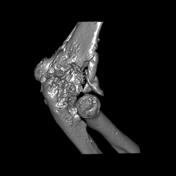212 results found
Article
Sports injuries: overhead elbow
Overhead elbow sports injuries are a group of pathologies seen in sports activities with overhead throwing or strokes, e.g. tennis, volleyball, baseball, javelin throwing. There has been a tremendous increase in the number of participants in these sports activities worldwide.
Pathology
During ...
Case
Ulnar collateral ligament injury - elbow

Published
27 Feb 2019
74% complete
MRI
Article
Common extensor tendon injury
Common extensor tendon injuries of the elbow include partial and complete tears or detachment of the common extensor tendon origin of the elbow and are commonly associated with lateral epicondylitis 1-4.
Epidemiology
Common extensor tendon injuries are the most common acute tendon injuries of ...
Article
Valgus instability of the elbow
Valgus instability of the elbow can develop as a result of ulnar collateral ligament injury either in the setting of chronic overuse or in the context of an acute or an acute-on-chronic injury.
Epidemiology
Valgus instability can be seen in athletes and less commonly in non-athletes.
Risk fac...
Case
Multi-ligamentous injury of the elbow with instability

Published
07 May 2020
100% complete
Annotated image
X-ray
MRI
Case
Complex soft tissue injuries following elbow dislocation

Published
03 Apr 2012
80% complete
MRI
Case
Shell splinter injury to the elbow

Published
01 Mar 2012
75% complete
CT
Article
Pediatric elbow radiograph (an approach)
Pediatric elbow radiographs are commonly encountered in the emergency department and, when approached in a systematic fashion, are not as difficult to interpret as most people think!
Systematic review
Ossification
Check that the ossification centers are present and in the correct position. Th...
Article
Valgus extension overload syndrome
Valgus extension overload syndrome, also known as pitcher's elbow, refers to a constellation of symptoms and pathologies commonly seen in overhead throwing athletes secondary to high repetitive tensile, shear and compressive forces generated by the overhead throwing motion.
The syndrome may cor...
Article
Distal biceps tendon injury
Distal biceps tendon injuries refer to strains, partial and complete tears of the distal biceps tendon complex.
Epidemiology
Distal biceps tendon injuries are far less common than injuries to the proximal biceps tendon with an incidence of approximately 1.2/100000 1,2. They typically occur in ...
Article
Radial head fracture
Radial head fractures are, together with the radial neck fractures, relatively common injuries, especially in adults, although they can be occult on radiographs. Radial head fractures are the most common elbow fractures 5.
Epidemiology
Although fractures of the radial head are seen in all age...
Article
Flexor-pronator mass injury
A flexor-pronator mass injury or common flexor-pronator muscle injury is a muscle injury most commonly a muscle tear or strain of flexor-pronator muscles of the elbow joint.
Epidemiology
A flexor-pronator mass injury is an uncommon injury seen in athletes practising throwing sports. It can rar...
Article
Posteromedial elbow impingement
Posteromedial elbow impingement is a throwing-induced elbow injury caused by the mechanical bony or soft tissue abutment of the posteromedial elbow joint due to repetitive micro-trauma affecting the posteromedial fossa. It can occur in isolation or as one manifestation of valgus extension overlo...
Article
Humerus series (summary)
This is a basic article for medical students and other non-radiologists
A humerus series (or humerus x-ray) is a set of two x-rays performed of the entire humerus. It is performed to look for evidence of injury (or pathology) affecting the humerus. It may be performed as a second test after a s...
Article
Elbow dislocation
Elbow dislocation is the second most common large joint dislocation in adults and the most common in children.
Epidemiology
Elbow dislocations are common and account for 10-25% of all elbow injuries in the adult population 1. They are the most common dislocation in children 4.
Associations
...
Article
Humerus series (pediatric)
The humerus series for pediatrics is a set of anteroposterior and lateral radiographs taken to investigate elbow joint pathology, often in the context of trauma.
As the elbow joint is also imaged in this series, being familiar with the order of elbow ossification is important in assessing the e...
Article
Proximal radial fracture (summary)
This is a basic article for medical students and other non-radiologists
Proximal radial fractures are the commonest elbow injury in adult patients and the injury most likely to cause an elbow joint effusion. Radial head and neck fractures are often subtle and may be occult on initial imaging.
...
Article
Forearm series (summary)
This is a basic article for medical students and other non-radiologists
A forearm series (or forearm x-ray) is a much less common study to perform than its neighboring elbow or wrist series. Forearm imaging may be performed in children because of difficulty to localize pain, or where there has ...
Article
Lateral epicondyle fracture (elbow)
Lateral epicondyle fractures of the elbow are rare epicondylar fractures. They are much rarer than medial epicondyle fractures and represent avulsion of the lateral epicondyle. They are usually seen in the setting of other injuries 1-3.
Terminology
These fractures are avulsion fractions of th...
Article
Adult elbow radiograph (an approach)
Systematic review
Whenever you look at an adult elbow x-ray, review:
alignment
fat pads for effusion
bony cortex
Alignment
Check the anterior humeral line:
drawn down the anterior surface of the humerus
should intersect the middle 1/3 of the capitellum
if it does not, think: distal hume...









 Unable to process the form. Check for errors and try again.
Unable to process the form. Check for errors and try again.